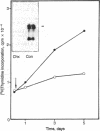Abstract
Binding of urokinase-type plasminogen activator (u-PA) to its receptor has been shown not only to focus proteolytic activity to the cell surface but also to exert a mitogenic effect on the human epidermal tumor cell line CCL 20.2. This report shows that u-PA is an autocrine mitogen in the human melanoma cell line GUBSB and that inhibition of receptor-bound u-PA by specific anti-u-PA antibodies causes a significant suppression of cell proliferation in this system. The GUBSB cell line secretes 70-80% of the u-PA in its active form and expresses high-affinity u-PA receptors with a Kd of 5.2 x 10(-10) M and 2.8 x 10(4) binding sites per cell. Approximately 70% of the u-PA receptors on these cells are occupied by endogenously secreted u-PA. Addition of the monoclonal anti-u-PA antibody MPW5UK (10 nM), directed against the active site of u-PA, twice daily to the cell cultures resulted in a significant decrease of [3H]thymidine incorporation by the tumor cells, whereas a 10 times higher concentration of the monoclonal antibody MPW4UK, which does not inhibit plasminogen activator activity of u-PA, was necessary to achieve the same effect. In addition, diisopropyl fluorophosphate-inactivated u-PA, in a concentration 50-fold higher than the concentration necessary to saturate the u-PA receptor (250 pM), decreased [3H]thymidine incorporation similarly to the specific antibody, proving that active u-PA is required for the mitogenic effect. Inhibition of endogenous u-PA production by cycloheximide reduced [3H]thymidine incorporation significantly; after addition of exogenous u-PA, [3H]thymidine incorporation increased again in the cycloheximide-treated cells. Therefore, inhibition of receptor-bound u-PA might represent a tool not only to inactivate cell-bound proteolytic activity, necessary for invasion, but also to exert a specific antiproliferative effect on certain tumor cells.
Full text
PDF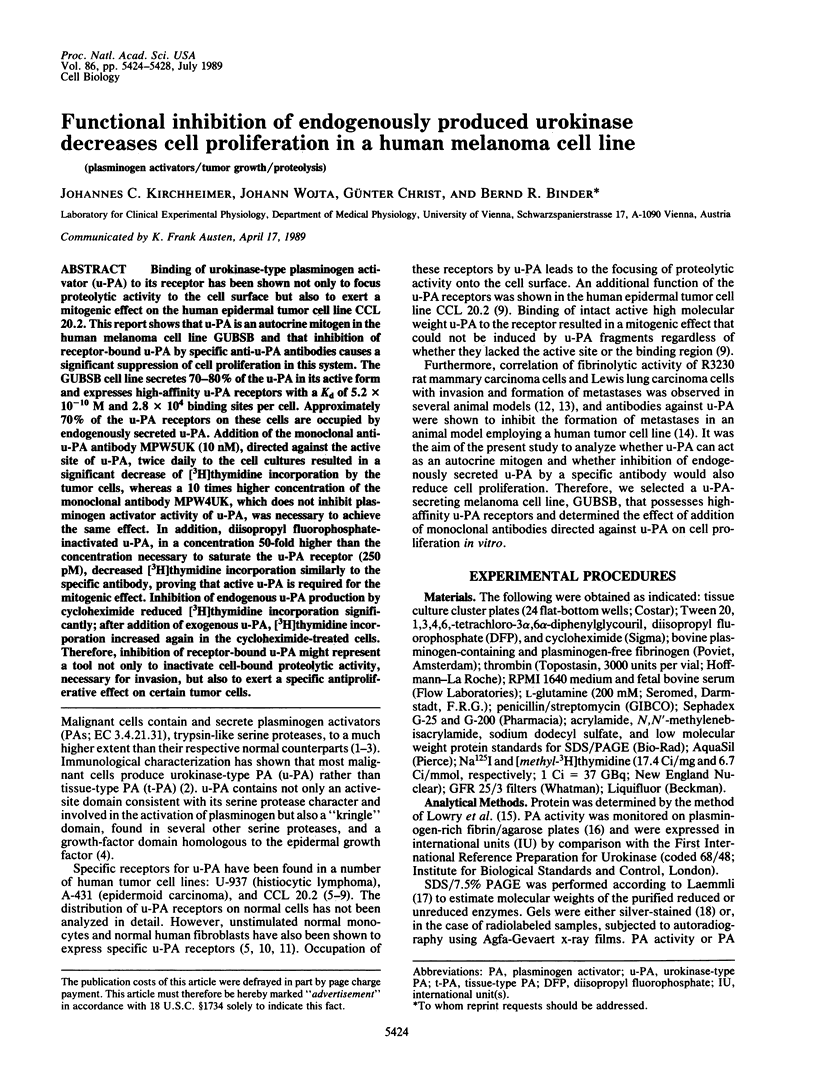
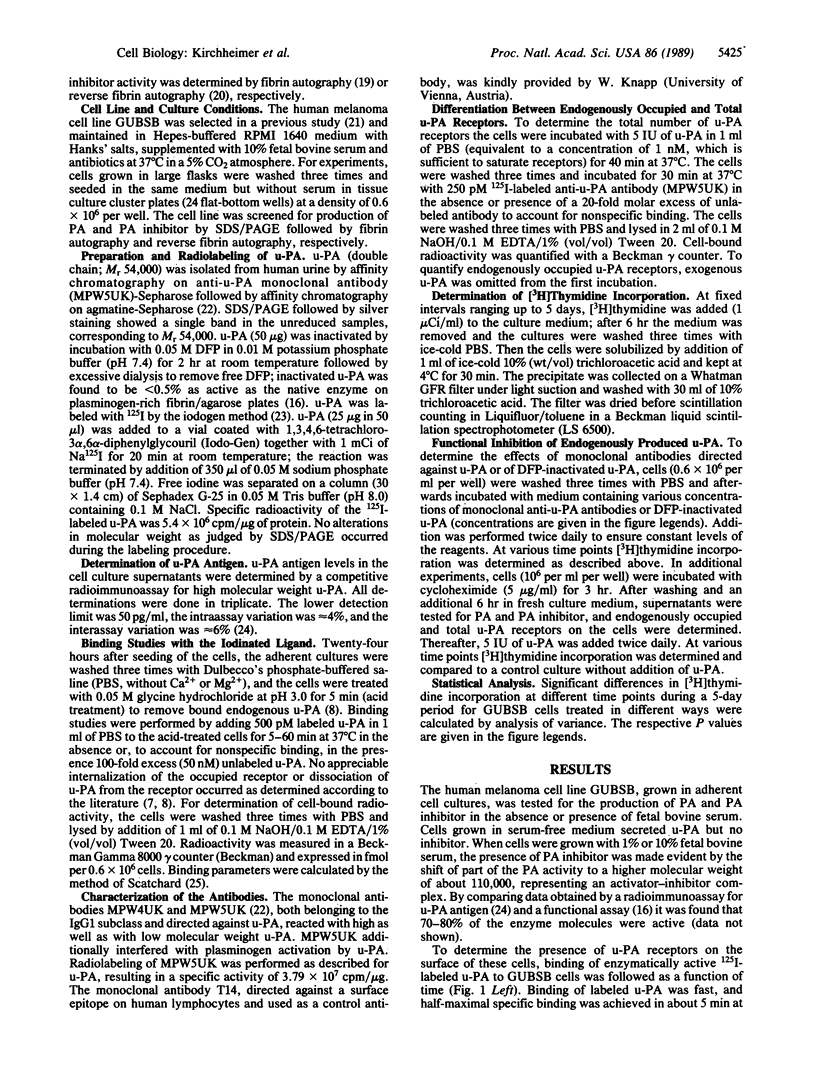
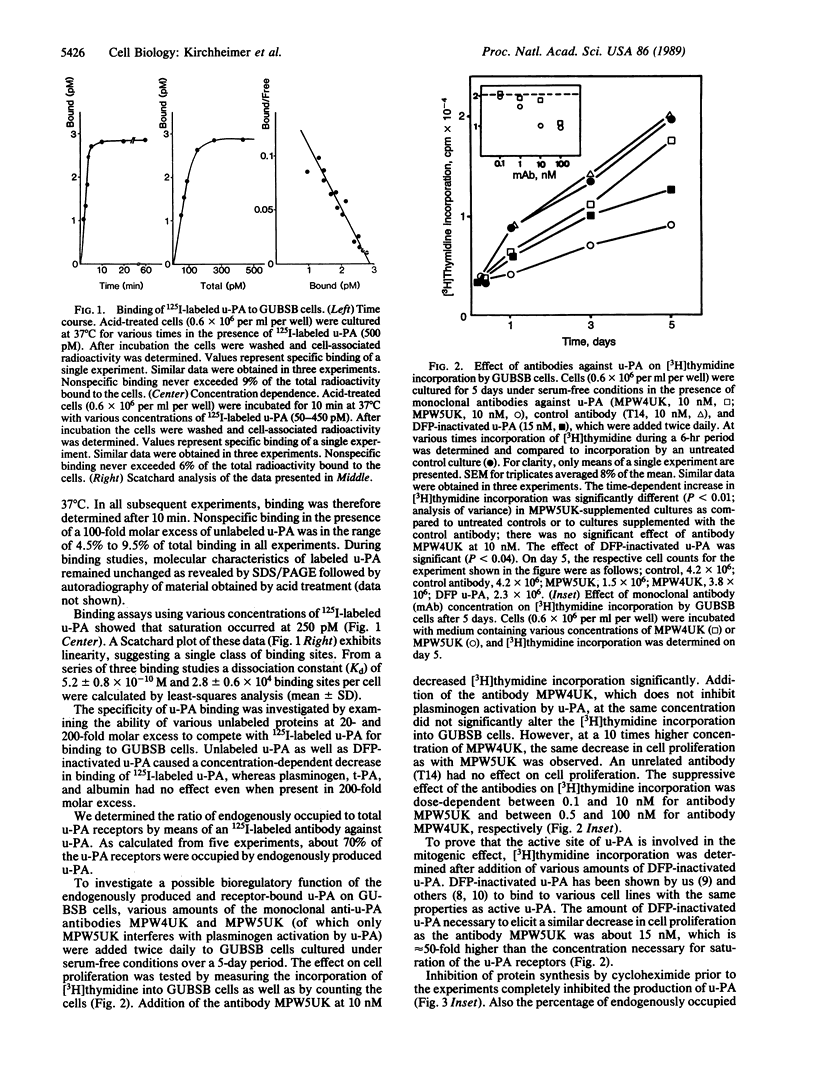
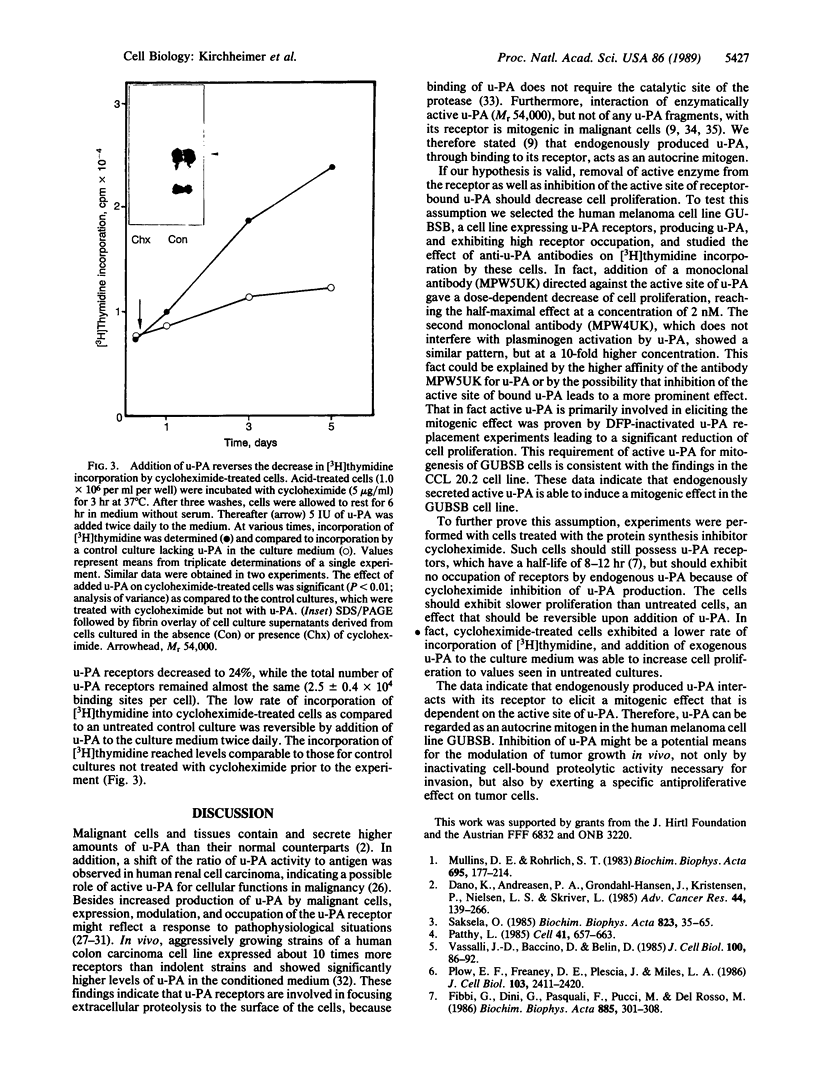
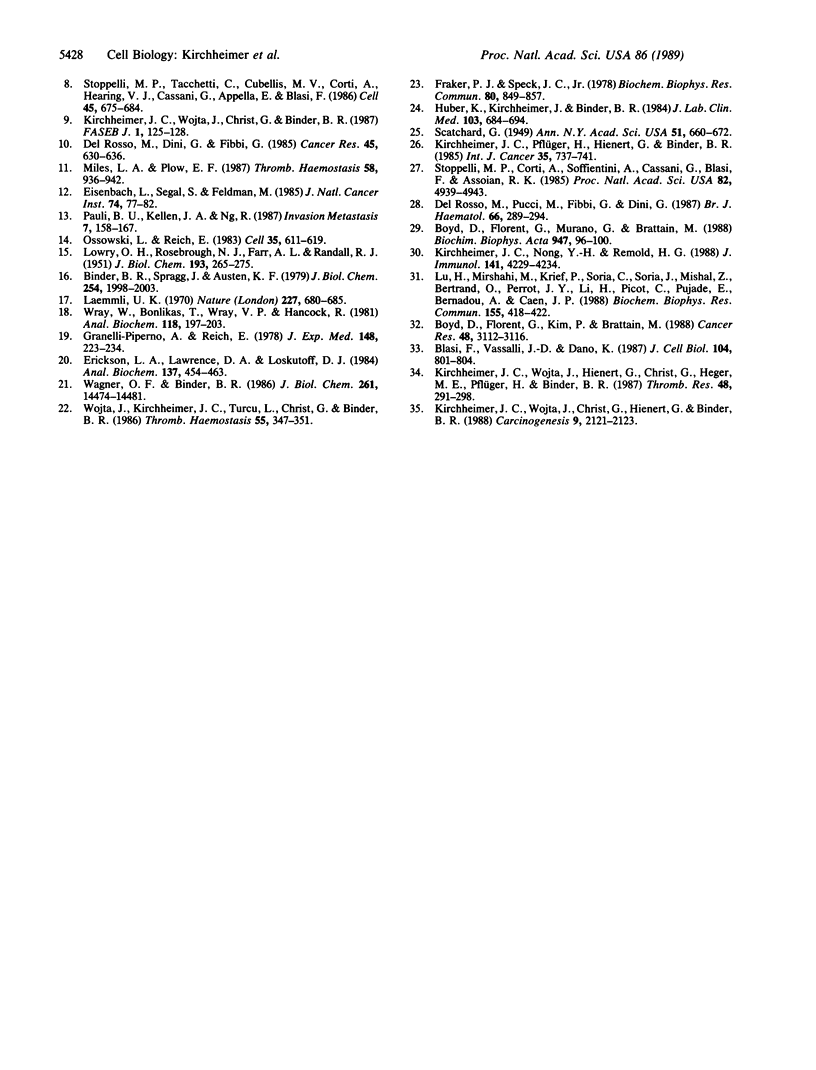
Images in this article
Selected References
These references are in PubMed. This may not be the complete list of references from this article.
- Binder B. R., Spragg J., Austen K. F. Purification and characterization of human vascular plasminogen activator derived from blood vessel perfusates. J Biol Chem. 1979 Mar 25;254(6):1998–2003. [PubMed] [Google Scholar]
- Blasi F., Vassalli J. D., Danø K. Urokinase-type plasminogen activator: proenzyme, receptor, and inhibitors. J Cell Biol. 1987 Apr;104(4):801–804. doi: 10.1083/jcb.104.4.801. [DOI] [PMC free article] [PubMed] [Google Scholar]
- Boyd D., Florent G., Kim P., Brattain M. Determination of the levels of urokinase and its receptor in human colon carcinoma cell lines. Cancer Res. 1988 Jun 1;48(11):3112–3116. [PubMed] [Google Scholar]
- Boyd D., Florent G., Murano G., Brattain M. Modulation of the urokinase receptor in human colon cell lines by N,N-dimethylformamide. Biochim Biophys Acta. 1988 Jun 8;970(1):96–100. doi: 10.1016/0167-4889(88)90227-3. [DOI] [PubMed] [Google Scholar]
- Danø K., Andreasen P. A., Grøndahl-Hansen J., Kristensen P., Nielsen L. S., Skriver L. Plasminogen activators, tissue degradation, and cancer. Adv Cancer Res. 1985;44:139–266. doi: 10.1016/s0065-230x(08)60028-7. [DOI] [PubMed] [Google Scholar]
- Del Rosso M., Dini G., Fibbi G. Receptors for plasminogen activator, urokinase, in normal and Rous sarcoma virus-transformed mouse fibroblasts. Cancer Res. 1985 Feb;45(2):630–636. [PubMed] [Google Scholar]
- Del Rosso M., Pucci M., Fibbi G., Dini G. Interaction of urokinase with specific receptors abolishes the time of commitment to terminal differentiation of murine erythroleukaemia (Friend) cells. Br J Haematol. 1987 Jul;66(3):289–294. doi: 10.1111/j.1365-2141.1987.tb06912.x. [DOI] [PubMed] [Google Scholar]
- Eisenbach L., Segal S., Feldman M. Proteolytic enzymes in tumor metastasis. I. Plasminogen activator in clones of Lewis lung carcinoma and T10 sarcoma. J Natl Cancer Inst. 1985 Jan;74(1):77–85. [PubMed] [Google Scholar]
- Erickson L. A., Lawrence D. A., Loskutoff D. J. Reverse fibrin autography: a method to detect and partially characterize protease inhibitors after sodium dodecyl sulfate--polyacrylamide gel electrophoresis. Anal Biochem. 1984 Mar;137(2):454–463. doi: 10.1016/0003-2697(84)90113-1. [DOI] [PubMed] [Google Scholar]
- Fibbi G., Dini G., Pasquali F., Pucci M., Del Rosso M. The Mr 17500 region of the A chain of urokinase is required for interaction with a specific receptor in A431 cells. Biochim Biophys Acta. 1986 Mar 14;885(3):301–308. doi: 10.1016/0167-4889(86)90245-4. [DOI] [PubMed] [Google Scholar]
- Fraker P. J., Speck J. C., Jr Protein and cell membrane iodinations with a sparingly soluble chloroamide, 1,3,4,6-tetrachloro-3a,6a-diphrenylglycoluril. Biochem Biophys Res Commun. 1978 Feb 28;80(4):849–857. doi: 10.1016/0006-291x(78)91322-0. [DOI] [PubMed] [Google Scholar]
- Granelli-Piperno A., Reich E. A study of proteases and protease-inhibitor complexes in biological fluids. J Exp Med. 1978 Jul 1;148(1):223–234. doi: 10.1084/jem.148.1.223. [DOI] [PMC free article] [PubMed] [Google Scholar]
- Huber K., Kirchheimer J., Binder B. R. Characterization of a specific anti-human urokinase antibody: development of a sensitive competition radioimmunoassay for urokinase antigen. J Lab Clin Med. 1984 May;103(5):684–694. [PubMed] [Google Scholar]
- Kirchheimer J. C., Nong Y. H., Remold H. G. IFN-gamma, tumor necrosis factor-alpha, and urokinase regulate the expression of urokinase receptors on human monocytes. J Immunol. 1988 Dec 15;141(12):4229–4234. [PubMed] [Google Scholar]
- Kirchheimer J. C., Pflüger H., Hienert G., Binder B. R. Increased urokinase activity to antigen ratio in human renal-cell carcinoma. Int J Cancer. 1985 Jun 15;35(6):737–741. doi: 10.1002/ijc.2910350607. [DOI] [PubMed] [Google Scholar]
- Kirchheimer J. C., Wojta J., Christ G., Binder B. R. Proliferation of a human epidermal tumor cell line stimulated by urokinase. FASEB J. 1987 Aug;1(2):125–128. doi: 10.1096/fasebj.1.2.3038646. [DOI] [PubMed] [Google Scholar]
- Kirchheimer J. C., Wojta J., Christ G., Hienert G., Binder B. R. Mitogenic effect of urokinase on malignant and unaffected adjacent human renal cells. Carcinogenesis. 1988 Nov;9(11):2121–2123. doi: 10.1093/carcin/9.11.2121. [DOI] [PubMed] [Google Scholar]
- Kirchheimer J. C., Wojta J., Hienert G., Christ G., Heger M. E., Pflüger H., Binder B. R. Effect of urokinase on the proliferation of primary cultures of human prostatic cells. Thromb Res. 1987 Nov 1;48(3):291–298. doi: 10.1016/0049-3848(87)90441-5. [DOI] [PubMed] [Google Scholar]
- LOWRY O. H., ROSEBROUGH N. J., FARR A. L., RANDALL R. J. Protein measurement with the Folin phenol reagent. J Biol Chem. 1951 Nov;193(1):265–275. [PubMed] [Google Scholar]
- Laemmli U. K. Cleavage of structural proteins during the assembly of the head of bacteriophage T4. Nature. 1970 Aug 15;227(5259):680–685. doi: 10.1038/227680a0. [DOI] [PubMed] [Google Scholar]
- Lu H., Mirshahi M., Krief P., Soria C., Soria J., Mishal Z., Bertrand O., Perrot J. Y., Li H., Picot C. Parallel induction of fibrinolysis and receptors for plasminogen and urokinase by interferon gamma on U937 cells. Biochem Biophys Res Commun. 1988 Aug 30;155(1):418–422. doi: 10.1016/s0006-291x(88)81102-1. [DOI] [PubMed] [Google Scholar]
- Miles L. A., Plow E. F. Receptor mediated binding of the fibrinolytic components, plasminogen and urokinase, to peripheral blood cells. Thromb Haemost. 1987 Oct 28;58(3):936–942. [PubMed] [Google Scholar]
- Mullins D. E., Rohrlich S. T. The role of proteinases in cellular invasiveness. Biochim Biophys Acta. 1983 Dec 29;695(3-4):177–214. doi: 10.1016/0304-419x(83)90011-2. [DOI] [PubMed] [Google Scholar]
- Ossowski L., Reich E. Antibodies to plasminogen activator inhibit human tumor metastasis. Cell. 1983 Dec;35(3 Pt 2):611–619. doi: 10.1016/0092-8674(83)90093-4. [DOI] [PubMed] [Google Scholar]
- Patthy L. Evolution of the proteases of blood coagulation and fibrinolysis by assembly from modules. Cell. 1985 Jul;41(3):657–663. doi: 10.1016/s0092-8674(85)80046-5. [DOI] [PubMed] [Google Scholar]
- Pauli B. U., Kellen J. A., Ng R. Correlation of fibrinolytic activity with invasion and metastasis of R3230 AC rat mammary carcinoma cell lines. Invasion Metastasis. 1987;7(3):158–171. [PubMed] [Google Scholar]
- Plow E. F., Freaney D. E., Plescia J., Miles L. A. The plasminogen system and cell surfaces: evidence for plasminogen and urokinase receptors on the same cell type. J Cell Biol. 1986 Dec;103(6 Pt 1):2411–2420. doi: 10.1083/jcb.103.6.2411. [DOI] [PMC free article] [PubMed] [Google Scholar]
- Saksela O. Plasminogen activation and regulation of pericellular proteolysis. Biochim Biophys Acta. 1985 Nov 12;823(1):35–65. doi: 10.1016/0304-419x(85)90014-9. [DOI] [PubMed] [Google Scholar]
- Stoppelli M. P., Corti A., Soffientini A., Cassani G., Blasi F., Assoian R. K. Differentiation-enhanced binding of the amino-terminal fragment of human urokinase plasminogen activator to a specific receptor on U937 monocytes. Proc Natl Acad Sci U S A. 1985 Aug;82(15):4939–4943. doi: 10.1073/pnas.82.15.4939. [DOI] [PMC free article] [PubMed] [Google Scholar]
- Stoppelli M. P., Tacchetti C., Cubellis M. V., Corti A., Hearing V. J., Cassani G., Appella E., Blasi F. Autocrine saturation of pro-urokinase receptors on human A431 cells. Cell. 1986 Jun 6;45(5):675–684. doi: 10.1016/0092-8674(86)90782-8. [DOI] [PubMed] [Google Scholar]
- Vassalli J. D., Baccino D., Belin D. A cellular binding site for the Mr 55,000 form of the human plasminogen activator, urokinase. J Cell Biol. 1985 Jan;100(1):86–92. doi: 10.1083/jcb.100.1.86. [DOI] [PMC free article] [PubMed] [Google Scholar]
- Wagner O. F., Vetterlein M., Binder B. R. Purification of an active plasminogen activator inhibitor immunologically related to the endothelial type plasminogen activator inhibitor from the conditioned media of a human melanoma cell line. J Biol Chem. 1986 Nov 5;261(31):14474–14481. [PubMed] [Google Scholar]
- Wojta J., Kirchheimer J. C., Turcu L., Christ G., Binder B. R. Monoclonal antibodies against human high molecular weight urinary urokinase: application for affinity purification of urinary prourokinase. Thromb Haemost. 1986 Jun 30;55(3):347–351. [PubMed] [Google Scholar]
- Wray W., Boulikas T., Wray V. P., Hancock R. Silver staining of proteins in polyacrylamide gels. Anal Biochem. 1981 Nov 15;118(1):197–203. doi: 10.1016/0003-2697(81)90179-2. [DOI] [PubMed] [Google Scholar]



